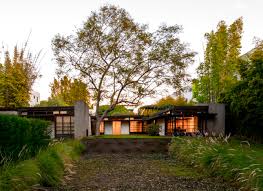Session 9: An Organic Approach to Modernism
- Sofía I. Capllonch

- Oct 17, 2020
- 3 min read
Updated: Dec 2, 2020
Modernism, having its European Bauhaus origins, went through a series of transformations through time; especially upon reaching the other side of the world. This evolution, led in America by Frank Lloyd Wright, gave a whole new connotation to modernism, tying it with nature and the human experience of inhabiting a space. The idea of synergy between these concepts was further explored by Rudolph Schindler, another key figure in American Modernism who learned from Frank Lloyd Wright himself. For the purpose of this entry, we’ll take a look at some of Wright and Schindler’s most notable designs: Taliesin East and the Schindler House, respectively; as well as their contributions to modernism as we know it today.
Frank Lloyd Wright is recognized as one of the most influential designers of all time. From construction techniques to conceptual development, Wright is better known for his methodology when designing, which resulted in a variety of amazing works of organic architecture. This term, coined by him, is not exclusively aesthetic; instead, it references the use of locally sourced materials, and more importantly, the relationship between a building and its natural surroundings. Following this approach, and influenced by his Unitarian spirituality, Wright designed Taliesin, which served as both his home and his studio. Completed in 1911, Taliesin lies upon a serene Wisconsin field, its hues emulating the Wisconsin River’s sand and limestone, which was also used as a construction material. The use of an open floor plan and wide windows allowed for further spatial freedom and illumination, while some instances of structural experimentation, such as the flying “Bird Porch”, fulfill Wright’s architectural vision. Together, all these elements characterize Taliesin as a summary of Wright’s impact on modern architecture.
Organic architecture, as Wright envisioned it, and its role on live-work spaces, was explored and reinterpreted by other designers, particularly in the work of Rudolf Schindler. Upon relocating to the United States and joining Wright’s practice, Schindler became inspired with Taliesin and its seamless adaptation to its natural surroundings, setting out to design an appropriate studio home of his own: the Schindler House. Also known as Kings Road House, the design served as a duplex housing, accommodating an additional couple. Similar to Wright, Schindler used an open plan, albeit with dividing walls similar to Japanese shoji partitions. Although modular, the house itself was not prefabricated, but instead, used concrete panels which were cast onsite over a customized wooden framework to create slits of natural lighting; but instances of outdoor nature did not end here. Schindler’s most experimental move was the creation of sleeping porches, a series of designated sleeping areas over the apartment roofs, intended to demonstrate the possibility of habitable exterior spaces. While radical in some aspects such as this one, Schindler’s design helped define Southern California Modernism as a style.
It’s worth noting that, having been designed by their respective inhabitants, both Taliesin and the Schindler House are personal representations of both designers and their posture towards an architecture that responds to the human need of being in close contact to nature. While Wright focused on the poetic and spiritual sides of nature-infused design, and Schindler ventured towards communal and outdoor living, both tendencies certainly point towards a return to the past; a return to the primitive. But then, were these designers ahead of their time by reminiscing on the past? According to Giorgio Agamben's stance on contemporaneity, the answer is definitely a yes.
References:
Craven, J. (n.d.). Exploring the 1922 Schindler House and the Architect Who Designed It. Retrieved October 19, 2020, from https://www.thoughtco.com/rm-schindler-house-4064503
Fiederer, L. (2016, March 16). AD Classics: Kings Road House / Rudolf Schindler. Retrieved October 19, 2020, from https://www.archdaily.com/783384/ad-classics-kings-road-house-rudolf-schindler
Getting Personal with Frank Lloyd Wright: Taliesin and Taliesin West. (2017, July 26). Retrieved October 19, 2020, from https://franklloydwright.org/getting-personal-frank-lloyd-wright-taliesin-taliesin-west/
Jones, I. M. (Director). (2017). Frank Lloyd Wright: The Man Who Built America [Video file]. UK: BBC. Retrieved October 17, 2020, from https://www.youtube.com/watch?v=1O7ax1KhJNM














Comments